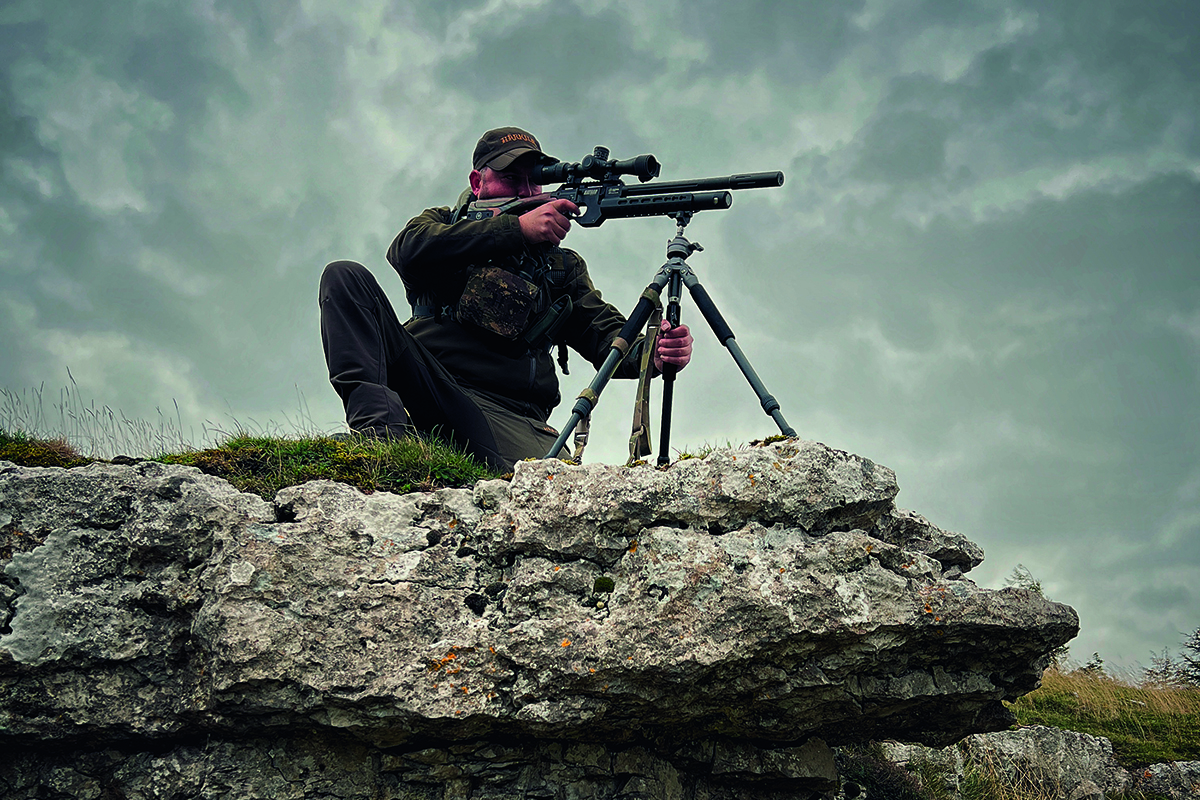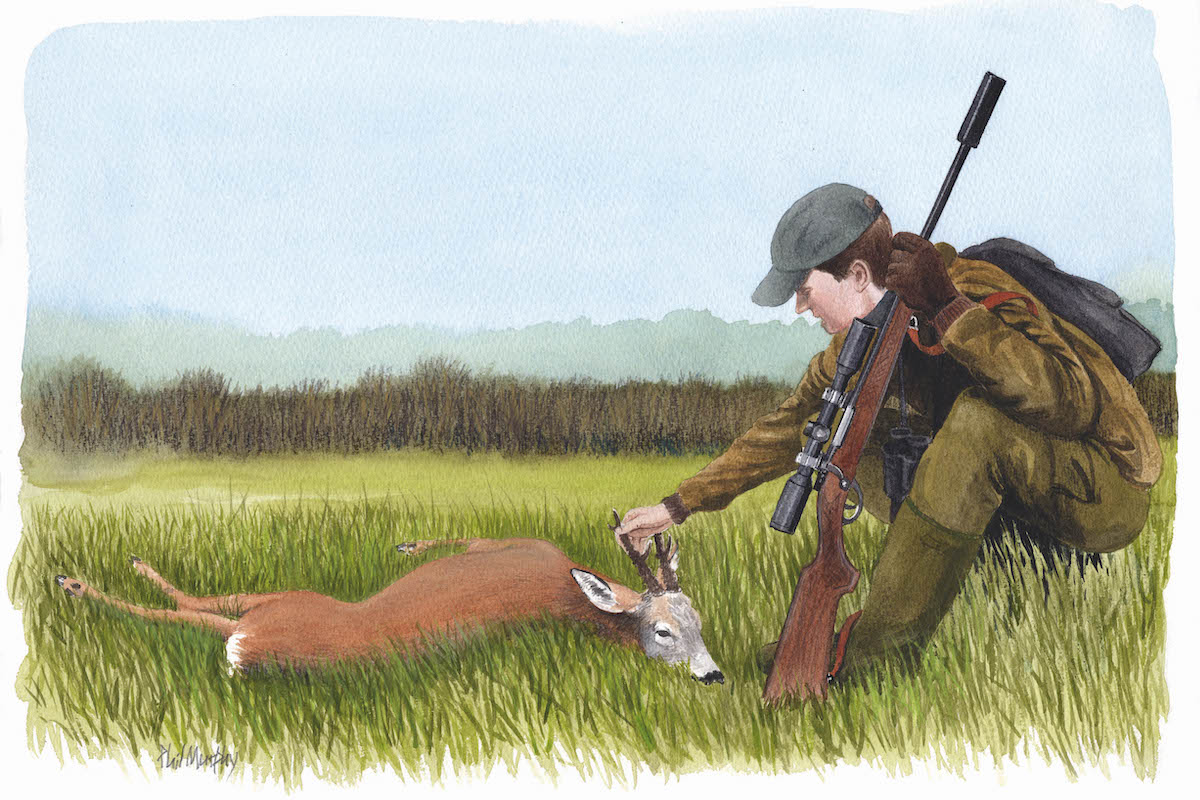Should airgunners try deer stalking?
Dedicated airgun hunter Lee Perryman finally goes deer stalking, but will the experience make him cast aside air in favour of powder?

This is Lee doing what he loves best – hunting with an air rifle – but on this occasion he had an invitation to go to Scotland in order to stalk a roe deer
I wonder how many of us have been out on one of our favourite permissions, stalking squirrels in a wood for example, only to wonder what it would be like to take on a totally different type of shooting? I’m lucky, because I have a lot of friends who know how passionate I am about field sports in general and shooting in particular, and consequently I’ve had plenty of invitations to go deer stalking.
The time has come
The thought of actually getting out there and doing this had been rolling around inside my head for quite some time. Any hesitancy I’d previously displayed had nothing to do with the shooting of high-powered rifles, but rather the thought of taking on a totally different and majestic animal compared with the quarry that I normally shoot when I’m out in the woods with my airgun.
But the time had finally come. The right invitation had been laid on the table and my mind was set. However, I decided that if I was going to take a deer then it wouldn’t be from a farm park or a high seat. I didn’t want an easy ride; I wanted to work for it. And that meant stalking.
The invitation to shoot a roe deer had been made by a new friend of mine called Peter Gibbon, who is a professional deer stalker and keeper. The location was in the far north of Scotland in a place called Turriff in Aberdeenshire, an eight-hour drive from where I live.
After setting off for my new adventure in my Suzuki Jimny, I couldn’t help but wonder whether I’d actually be able to go through with it. At that point I didn’t really think it even mattered.

While Lee enjoys shooting in open spaces, his preferred type of air rifle hunting is having a woodland walkabout for grey squirrels
My mindset was that if I managed to get on a deer, place the reticle over the killzone but couldn’t take the shot, I would just say ‘bang’, and with that I would have accomplished what I had set out to do.
After reaching the destination (which felt like years later), I was greeted by Peter at one of his permissions. I was then handed a .223, which is a roe-legal calibre in Scotland, and a .308, plus five rounds for each, and was asked to shoot out to 100 yards to a conveniently placed deer target.
I was in the middle of nowhere, with a guy I’d never actually met before, shooting off quad sticks which I rarely use, using two high-powered centrefire rifles that I’d never shot before and on a windy Scottish hillside. What could possibly go wrong?!
I cleared my mind, and put the five rounds from each rifle into a tight group well within the kill zone, which Peter seemed more than happy with. After being asked which calibre I wanted to opt for, I chose the .223 as there was less recoil than the .308, but obviously a lot more than my usual sub-12 ft-lb airgun. The other advantage the .223 had was its weight. Because it was lighter, I thought it would be more suitable for an all-day carry. Peter finished off the session by saying, “I guess I will see you in the morning then.” I was left feeling both nervous and excited.

Good fieldcraft is vital to a successful hunt, whether the quarry is a feral pigeon, rabbit, squirrel or deer
Out on the fells
After being picked up at seven and whisked off down the narrow country roads to one of Peter’s permissions, we parked up, carried out our safety checks of the rifle and other equipment, then headed off into the woodland. As soon as the stalk began, I soon blended into what could be called Peter’s shadow. Anyone who shoots and stalks squirrels knows that stealth is key, and since I’ve been shooting squirrels for so long I was well prepared for it.
The woodland didn’t offer any promising spots, so we headed out onto the clear fell. This terrain was new to me and something I hadn’t encountered before, tree fell flatlands with high grass-covered sinkholes ready to break your ankle at any point. I was just glad I was wearing my 12in high Härkila boots for all that extra support.
Working hard to stealthily cross the clear fell, we made a few deer spots in the far distance, but unfortunately they were ranged at 800 yards and on a neighbouring property. After a few hours we called it, as a much-needed food break was in order. Whilst we chatted about each other’s field sports and background interests, we crossed back over the clear fell, through the woodland and back to the truck for me to be dropped off and then picked up again a couple of hours later.
Before I knew it the time had passed, and we were back in the truck driving to yet another permission. Again, we carried out another safety check before we took off on our stalk. An hour or so later, and just before reaching another clear fell, a roe doe (a female deer) passed on a track 200 yards in front of us.
We both stopped and looked at each other, and we must have been thinking the same thing. Normally where there is a doe there is a buck (a male deer) nearby, and sure enough there he was, spotted at 198 yards on the Pulsar Axion XQ35 LRF to the right and down in the middle of the clear fell.

Lee and Peter drew a blank when searching for a roe in the woods, so turned their attention to the fells instead
We dropped to our knees and crawled 40 yards to the edge of the fell. With the wind in our faces, Peter stuck his head up to have a look and make sure we hadn’t been made. He ranged the buck at 158 yards, so he pointed to a tree stump for me to position the rifle on using a bipod.
That was a relief for me, as it meant I wouldn’t have to use the quad sticks. Slowly, as I brought the gun up to rest on the stump, I could clearly see the buck, who was now standing side-on. You couldn’t have asked him to stand in a better position, and he was completely unaware that we were even there.
Taking the shot
As I watched the buck through the scope, the reticle was drawing circles around the animal. It was at that moment that I realised what American hunters mean when they talk about “buck fever”. I slowed my breathing down until the reticle came to rest on the killzone. I heard Peter ask, “Have you got a shot?” I confirmed that I had, and then he replied, “Take it.”
I squeezed the trigger. The buck ran 10 yards and dropped. I reloaded in case I needed a follow-up shot, but there was no movement. Peter turned to me and congratulated me on my first deer. He handed me a flask, but I refused because I wouldn’t have been able to have drunk any without spilling it everywhere, with the adrenaline still buzzing around inside me. But what a feeling! It was a real mixture of emotions and excitement.
The guideline time of 30 minutes elapsed, so we made our way down the clear fell, and it didn’t take as long to find the buck as one of my tree-shot squirrels would have been. After the safety checks were made to make sure the buck was indeed dead, Peter pointed out the entry and exit wounds. It was clear to see that it had been a perfect heart shot, ensuring a clean, humane kill.
The next step was to gralloch the buck. This is something I hadn’t done before, although I have prepared quite a few rabbits in the field so I had some idea of what to expect. Peter showed me step by step what to look for with signs of tuberculosis and how to clinically field-prep the buck. Upon further inspection it looked like the buck had lived a hard life, with his worn-down teeth, broken antler and long-ago broken but healed rib cage, which looked like it could have been caused in a rut.

There has to be a reason to take an animal’s life, and in this case roe bucks can be very destructive towards trees, especially during the rut
Hearing and seeing all this made me feel a lot better, especially knowing the buck might not have survived the winter. After the gralloch process had been carried out, it was only tradition that the one who shoots the deer carries the deer out, which I thought was more than reasonable.
Later on in the evening after I had been dropped off, Peter called me and said that he had prepared the skull and due to the weight of it, I was looking at a medal. This is something I hadn’t set out looking for, but just adds to the memories.
All in all, it felt like everything played out perfectly for me – the weather, the conditions, the distance and the deer. It was a brilliant experience, but does this mean that I would give up my airgun squirrel hunting for deer stalking? No way.








